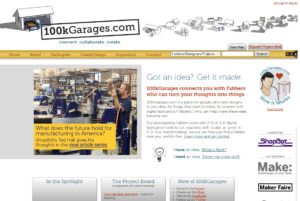Looking for the Future
05 27 2013
As promised in the last blog post, this time we will be touching on "Distributive Manufacturing". The words are really just a formal way of expressing an idea that has been around for a long time, but I believe it is going to become VERY important soon. So let's discuss what it really means.
Distributive manufacturing is the de-centralization of where things get made. Not long ago, steel was largely made in Pittsburgh, cars in Detroit, electronics in Japan, etc. This is centralized manufacturing, and in the world of the time it made economic sense. A lot of our customers are cabinet makers, body shop or custom car folks and the like. These industries have pretty much always been widely distributed where the customers are. Custom cabinets for example, have always been a local business. Cabinet boxes can be built anywhere, but the logistics of designing, measuring, fitting and installing lend themselves to local attention far more than trying to ship them in from a long way off. This is the Distributive Manufacturing model, and it is beginning to spread to MANY other fields, including those that have long been centralized.

It begins with the easy and free flow of information globally. Any reasonably intelligent adult can now aquire and use software to create a 3D model of a product they wish to own, even if it does not currently exist. And the technology to make products from 3D computer models is becomming cheaper and more accessable every day. Want a couple of custom pasta measures made for Christmas gifts? No problem. Draw it out, email it to a local shop and they can cut them in wood or plastic in a matter of hours and with machines costing as little as $3500.00 currently. Need a set of ten barbeque spatulas made with your restuarant logo cut into the blade? Easy, send your file to a local shop with a $5,000.00 CNC plasma cutter and they will make them in stainless steel. I needed a pair of plastic brackets when the ones on my microwave broke this month. They were pretty complex with compound curves, through holes, bosses and details on four sides. I created a 3D model and printed them out on my $1400.00 3D printer in less than four hours start to finish.

Now imagine how easy it would be if the microwave manufacturer had the 3D models or such parts available online for around $5.00 Anyone can pay the fee, download the file and have the part made locally. No packaging, no shipping, no need to make and store parts from discontinued models in the hope that they might someday sell. No more need to replace a $400.00 microwave because of a couple of cheap plastic parts that are no longer available. Sound too good to be true? Teenage Engineering, a Swedish manufacturer of synthesizers, has already posted 3D models of many of their plastic accessory pieces on their website. These parts retail for $12-14 each but shipping costs make them prohibitive for US customers to buy. Imagine now if GE, Whirlpool and other appliance makers did the same.

This return to "cottage industry" is a growing trend. Magazines devoted to the "Maker" movement are available at newsstands, groups are all over the internet sharing tips and techniques, and ShopBot Tools, a manufacturer of entry level CNC machines has started a program called "100KGarages" to connect 'makers' (largely but not exclusively ShopBot owners) with customers who need or want prototypes and short runs made to their designs and specifications. Consumers are more than ever wanting to support their local economy, avoid cheap throw-away products, and actually know who makes their posessions.
Companies that see these changes coming and embrace them rather than try to stop them will prosper in the next decade or two. There is a lot to think about in this and we would love to hear your take on these ideas. Get in touch here on this blog, on our Facebook page, or via Twitter. -2Sand.com

